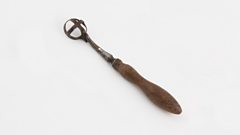Science Museum mystery objects; home security camera security and Rosalind Franklin at 100
Can you help identify the Science Museum mystery objects? How secure is your home security camera? And Gareth explores the legacy of Rosalind Franklin in the centenary of her birth
The Science Museum Group looks after over 7.3 million items. As with most museums, the objects you see on display when you visit are only the tip of the iceberg of the entire collection. Up until now, many of the remaining 300,000 objects have been stored in Blythe House in London. But now the collection is being moved to a purpose-built warehouse in Wiltshire. The move is a perfect opportunity for curators to see what’s there, re-catalogue long hidden gems and to conserve and care for their treasures. But during the process they have discovered a number of unidentified items that have been mislabelled or not catalogued properly in the past and some of them are just so mysterious, or esoteric, that the Science Museum needs the aid of the public to help identify them, and their uses. We’ll be showcasing items over the next weeks and months, but this week, Jessica Bradford, the keeper of collection engagement at the Science Museum is asking Inside Science listeners if they recognise, or can shed light on the possible use of the ‘scoop’ in the picture above.
Send suggestions to Email: bbcinsidescience@bbc.co.uk or mysteryobject@sciencemuseum.ac.uk
People install and use home security cameras for peace of mind. But the very behaviour of the commonly used IP home security cameras (internet-connected security cameras) could be giving away important information about your household to potential burglars. Gareth Tyson, at Queen Mary University London, has been working with researchers in China to explore how we use these home security camera systems and to look for flaws in the security of security cameras.
Last Saturday, 25th July, was a hundred years since the birth of chemist Rosalind Franklin. She is perhaps most famous for her work using X-ray crystallography which helped lead to the discovery of the double helix structure of DNA, a contribution for which she was not credited at the time. But there’s so much more to the scientific story of her life than just being the wronged woman in the DNA story, who died tragically young at the age of just 37. She pioneered work in the coal industry and on the structure of viruses, including the polio virus. And Franklin’s work has resonance today, in this era of COVID-19. Baroness Nicola Blackwood, chair of Genomics England thinks Rosalind Franklin’s legacy is something we should be very proud of today.
Presenter - Gareth Mitchell
Producers - Fiona Roberts and Beth Eastwood
Last on
Clip
-
![]()
Can you help identify this mysterious ‘scoop'?
Duration: 03:49
Broadcasts
- Thu 30 Jul 2020 16:30�鶹�� Radio 4 FM
- Thu 30 Jul 2020 21:00�鶹�� Radio 4 FM
Explore further with The Open University
�鶹�� Inside Science is produced in partnership with The Open University.
Podcast
-
![]()
�鶹�� Inside Science
A weekly programme looking at the science that's changing our world.



